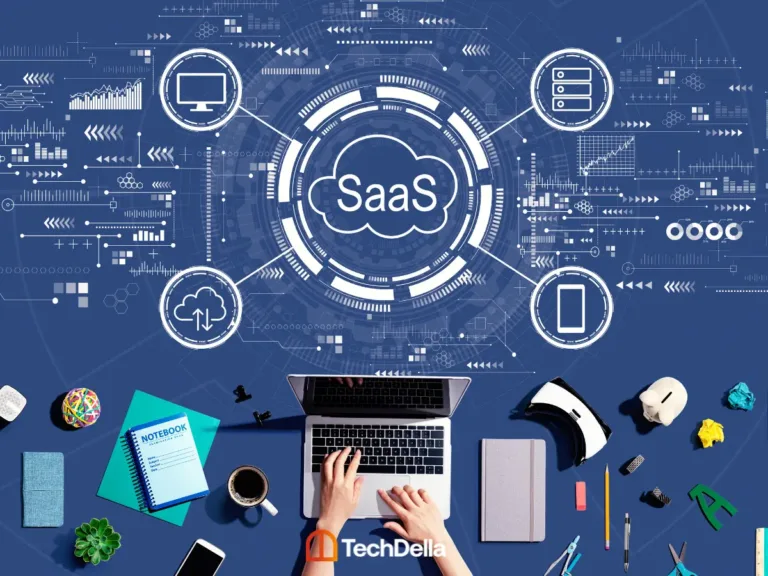
Are you an entrepreneur or a small business owner thinking of developing a SaaS product that can help businesses function effectively? That’s awesome! However, going through the SaaS product development process can be a daunting task.
To make your SaaS product development a success, you will need a solid roadmap and a dedicated team. Furthermore, before you start building your SaaS product, you’ll have to know what businesses need.
This is because knowing their needs will give you an idea of the necessary steps to take during your SaaS product development process. Additionally, it doesn’t matter if you’re new to the Saas product industry or if you already have an idea of SaaS products, this guide will walk you through how to launch a successful SaaS business, offering practical tips to help you build with clarity and confidence from day one
In this article, you’ll learn:
- What a SaaS product development?
- Benefits of developing a SaaS product
- Steps involved in developing a SaaS product
- Challenges faced when building a SaaS-based product
- Factors affecting the cost of SaaS product development and
What Is SaaS Product Development?
SaaS product development is the process of designing, building, testing, and implementing software applications that can be delivered to users as a service over the internet.
This approach eliminates the need for users to install these applications on their devices, as the SaaS provider hosts them. When developing SaaS products, various cycles are repeated to improve them. This ensures that customers get exactly what they need.
What Are The Benefits of Developing A Saas Product?
According to Devsquad, 86% of businesses have experienced growth in employee engagement since they began using SaaS products.
Also, 54% of businesses make use of SaaS products to increase their workers’ productivity. These statistics clearly show how helpful SaaS products have been since their introduction to the business world.
Aside from the benefits above, Saas product development has other benefits for small and large businesses. These include:
1. Competitive Advantage
Building a SaaS product for your SaaS development business or other businesses can give you an edge over your competitors in the market.
For example, if you check your competitor’s product, you might find out that it lacks a certain feature that customers need. Rather than coming up with a totally new idea, you can add the popularly demanded feature to your product during the SaaS product development process.
Doing this will give your product more visibility than that of your competitor. Additionally, if you build a SaaS product for your business, customers are likely to want to patronize it.
This is because SaaS products have a more flexible pricing plan, and data is stored in the cloud. No one would want to miss the chance of getting value for a more convenient price.
2. Scalability
Your business’s needs can change with an increase in customer growth. Sometimes, this growth can demand that some tools used at the beginning of the business be changed to increase work efficiency.
However, this isn’t so for SaaS products. SaaS products are built to accommodate various business needs, no matter how large a business grows.
3. Automatic Updates
Unlike traditional software that requires users to manually update it in order to enjoy new features or enhancements, SaaS products are different.
SaaS products don’t require manual updates. Any update is made by SaaS providers, who ensure that their products stay up-to-date without interrupting usage or user intervention.
4. Lower Upfront Costs Upfronts
SaaS products operate on a subscription-based licensing model. This means you don’t have to pay a large sum to access all of its features. Instead, you can decide on the plan that best suits your business needs and either subscribe to a monthly or yearly plan, depending on your budget.
5. Accessibility
Accessibility is one major benefit of SaaS product development. This is because there aren’t any restrictions when it comes to using SaaS products. These products can be used by businesses with workers spread across the globe for work purposes.
As a business owner, you don’t have to worry about collaboration and productivity amongst your workers who are in different locations. This is because SaaS products make productivity and collaboration easy. All that is needed is a strong internet connection.
How To Develop A Saas Product
The SaaS product development life cycle consists of 9 stages. None of these stages is more important than the other. Every single stage contributes to the success of your SaaS product development.
1. Have A SaaS Product Development Roadmap
A SaaS product development roadmap is simply a visual representation of your product goals, targets, improvements, visions, and priorities. It allows you to present your product idea to a stakeholder or investor.
Also, a SaaS product roadmap would help your team know your goals and plans for the SaaS product. It will really be helpful to them during the SaaS product development process, as it can be used to track the progress made.
When designing your Saas product roadmap, you’ll have to answer questions like:
- What are the primary objectives and goals of the SaaS product?
- Who is my target audience or user persona for the product?
- What are the key features and functionalities that need to be developed?
- What is the timeline for each SaaS product development phase
- What resources, including budget, team members, and technology, are required for the project?
- How will the product be marketed and launched to the target audience?
- What metrics will be used to measure the success of the product, and how will they be tracked?
- How will the product be maintained and updated after the initial launch?
By answering these questions, you can be sure that your overall vision and objectives for the SaaS product will be followed.
2. Conduct A Market Analysis
Before starting your SaaS product development, you’ll have to know if your product is needed. You don’t want to develop a product that doesn’t solve the problems of your target audience. However, you can tackle the problems of your audience by identifying their demands, needs, and preferences.
Knowing this will help you determine your area of focus during your SaaS product development process. Additionally, you’ll have to confirm that your SaaS product idea isn’t already available in the market. If it is, you’ll have to look for the features missing in the product and find ways to improve yours.
3. Define Your SaaS-Based Product Requirements
During your SaaS product development process, you’ll have to prioritize some basic requirements like security, integration options, scalability, privacy protection, and customization.
Due to the increase in cyberattacks, consumers expect that whenever they sign up for a product or service, their private information will be protected. No one would be willing to use a product that doesn’t care about its users’ privacy.
So, when developing your product, you need to consider strict security measures to safeguard your users’ information. Finally, based on your discovery of your target audience’s needs, specify certain features that will be implemented in your product in order to meet their needs and solve their problems.
4. Estimate Your Saas Product Development Costs
When building a Saas product, you’ll need to estimate your Saas product development cost. Doing this will give you an idea of how much you’ll be spending on the design, coding, analysis, and marketing of the product.
Additionally, it’s important that you set aside emergency funds for unforeseen circumstances and challenges.
5. Choose Your Technology Stack
For this step, you’ll have to decide how you want your SaaS product developed. You’ll need to choose a SaaS product development framework for both backend and frontend development. For the front end, you can choose frameworks like React, Vue.js, Angular, and HTML, while frameworks like Node.js and Django can be used for the back end.
However, if you aren’t a website or software developer, you likely won’t have an idea of which framework is best. So, to save you from endless brainstorming, you can consult professionals who can help you.
6. Define Your Business/Pricing Model
When pricing your SaaS product, consider your users’ financial condition, needs, and habits. This will make it easier for you to gain more customers and grow your business.
While choosing a pricing strategy for your SaaS product, ensure you choose the right short-term model that can help you settle in the market. However, it is also important that you have a long-term pricing model in mind. This model should depend on your customers, SaaS product lifestyle, and long-term goals. Understanding how the SaaS business model works as a whole can provide helpful context for these decisions. This guide breaks it down clearly.
The most common models available in the SaaS product industry are as follows:
- Freemium
- Pricing per user
- Flat rate(usually paid monthly or yearly)
- Usage-based
- Pricing per feature
In addition to your pricing model, you must have a social media marketing strategy and an SEO strategy in place.
7. Design An MVP
MVP simply means minimum viable product. It is usually created by developers or businesses to meet the needs of their audience with reduced development costs. A minimum viable product contains core features that can meet the audience’s needs.
As a business owner, having a minimum viable product is the fastest way to check if your product meets the needs of your audience and also makes an entry into the market. Before designing an MVP, you’ll need to consider the following:
- Your target audience
- Ways they can solve their problems through your software
- Solutions to their problems
Considering the above-listed factors will give you an idea of the core features you need to add to your MVP.
8. Test And Iterate Your Product
This is the stage where the MVP is tested by early adopters in order to ensure that it meets the needs and desires of the target audience.
Taking an iterative approach will help the SaaS product development team make corrections to the course early. The team can test the product to confirm its viability before an extensive budget is committed to the course.
Additionally, you can gather feedback from users to help make the next iteration of the SaaS product better.
9. Check and Launch The Final Product
As the product undergoes various iteration processes, the product should be close to meeting the users’ needs and business goals. This also means that it’s getting closer to “done,” i.e., the way the team set out the project to be.
A proper definition of “done” is that unfinished work and rework costs are reduced. Lastly, a quality assurance test must be carried out before the product is launched.
This is to confirm that there are no defects available on the SaaS product. You can provide your SaaS product development team with the various criteria that need to be met while the QA is done.
What Are The Challenges Faced When Developing A SaaS-Based Product
As earlier stated, undergoing a SaaS product development process is a daunting task. As it has various benefits, there are also different challenges faced during the process.
1. Third-party Integration
This is one major challenge faced in SaaS product development. Integration of your product with other third-party apps is a complex task. It will require that your product has a well-written API and can support recent integration models.
To successfully integrate your product with other third-party software, you can make use of custom integrations. This will enable smooth sharing of data between email services, Payment gateways, and CRMs.
2. Scalability
When developing your SaaS product, you’ll need a scalable architecture. This is because as your users’ customer base grows, their workload will increase. So, to help them handle tasks and increase their productivity, your SaaS product must be able to cater to their needs at every stage.
You can partner with a SaaS product developer to ensure that your products are scalable, secure, and aligned with user feedback.
3. Data Privacy And Security
You’d have to ensure that protecting your users’ privacy is your top priority during your SaaS product development process. By implementing the right security measures, you’ll maintain trust among your users.
You can handle this challenge by making use of strict security measures, including routine security audits, data encryption, and access control management.
4. Providing Value To Customers
Keeping up with future trends and meeting the rising needs of customers can be difficult at times.
However, to constantly provide your customers with value, you can conduct market research and user analysis in order to identify your users’ needs and preferences.
5. User Adoption
It can be very difficult to convince people to use your SaaS product instead of sticking with an existing one. I’m sure you understand why, too. No one wants to spend their time on a product and get less value. To overcome this challenge, you’ll have to show the benefits of your SaaS product over that of your competitors.
You’ll also need to invest in effective marketing strategies like social media marketing, influencer marketing, or email marketing. These will give your brand some visibility. To build trust, you can create educational or engaging content targeted to your audience’s needs.
Factors Affecting The Cost Of Product Development
There are various factors that can affect your SaaS product development, and it is important that you’re aware of these factors.
Having an understanding of these factors will help you plan your development process effectively. Below are some important factors that you should consider.
1. Hosting
The type of infrastructure required to host a SaaS product can vary depending on various factors. These factors include scalability, performance, and reliability.
Cloud-based infrastructure services like Amazon Web Services (AWS), Microsoft Azure, or Google Cloud Platform can incur ongoing costs. These costs are based on usage, storage, and data transfer.
Furthermore, deciding between self-hosting and using a cloud provider will also affect upfront and ongoing infrastructure expenses.
2. Integration Requirements
Integrating your product with other third-party software or APIs can make the development process complex, thereby affecting the development costs. This is because it takes more time and effort to ensure that data can be shared seamlessly among the software.
3. Feature Complexity
If the SaaS product you’re developing is aimed at solving various problems all at once, there’s a chance that more features will be used.
Due to the increase in features available on the product, more effort, design, and implementation will be needed. All this can increase your SaaS product development cost. So, when planning your budget, take into consideration the various features you’ll be adding.
Start A SaaS Product Development To Help Solve The Needs Of Businesses
Undergoing a SaaS product development process requires effective planning, execution, and constant improvement. This process can be repeated over and over again till the desired outcome is met.
However, before you develop a SaaS product, it is important that you have an idea of the various steps that are required. Following these steps will help you develop a successful product.
Additionally, always have your customers in mind while developing the product. This will help you develop a SaaS product that meets their needs and can also keep you ahead of your competitors.
Lastly, if you’d like to present your idea to stakeholders or investors, it’s important that you have a SaaS product development roadmap. This roadmap will give them an idea of your goals, visions, timeline, and objectives for your product.
If you’re looking to build a SaaS product the right way from planning to execution, Techdella’s SaaS development solution offers the support and expertise you need at every stage of the journey.
Final Thoughts
Building a successful SaaS product takes more than just an idea—it requires planning, execution, and a deep focus on user needs. By following the steps in this guide, you’re well on your way to creating a product that stands out. And if you need expert guidance to turn your idea into a scalable SaaS solution, book a free discovery call with us. Let’s build something great together.
Related Marketing Strategies

How to Launch a Successful SaaS Business

From Startup to Global Player: Business Growth Process


